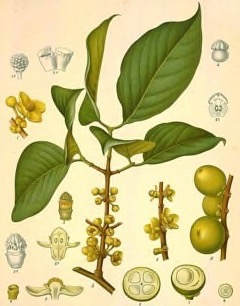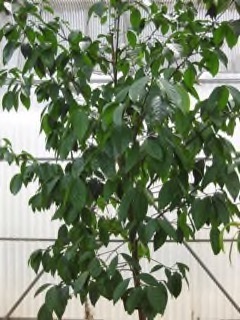 |
|
edibleplants.org |
 |
| Raffi Kojian - Gardenology.org |
Translate this page:
Summary
Physical Characteristics

 Garcinia hanburyi is an evergreen Tree growing to 15 m (49ft) by 15 m (49ft) at a medium rate.
Garcinia hanburyi is an evergreen Tree growing to 15 m (49ft) by 15 m (49ft) at a medium rate.
See above for USDA hardiness. It is hardy to UK zone 10.
Suitable for: light (sandy), medium (loamy) and heavy (clay) soils and prefers well-drained soil. Suitable pH: mildly acid, neutral and basic (mildly alkaline) soils and can grow in very acid soils.
It can grow in semi-shade (light woodland) or no shade. It prefers moist soil.
UK Hardiness Map
US Hardiness Map
Synonyms
Garcinia morella pedicellata Hanbury
Plant Habitats
Edible Uses
References More on Edible Uses
Medicinal Uses
Plants For A Future can not take any responsibility for any adverse effects from the use of plants. Always seek advice from a professional before using a plant medicinally.
The gum resin obtained from the trunk is a drastic purgative, an emetic, and a vermifuge used for treating tape worm[303 , 310 ]. It is no longer used in human medicine[303 ]. Gamboge is odourless and tasteless or slightly acid[303 ]. Large doses of gamboge, administered as a medicine, can be fatal[303 ].
References More on Medicinal Uses
The Bookshop: Edible Plant Books
Our Latest books on Perennial Plants For Food Forests and Permaculture Gardens in paperback or digital formats.

Edible Tropical Plants
Food Forest Plants for Hotter Conditions: 250+ Plants For Tropical Food Forests & Permaculture Gardens.
More

Edible Temperate Plants
Plants for Your Food Forest: 500 Plants for Temperate Food Forests & Permaculture Gardens.
More

More Books
PFAF have eight books available in paperback and digital formats. Browse the shop for more information.
Shop Now
Other Uses
The tree is valued because of the resinous sap, called gamboge, which exudes from incisions in the bark[303 , 310 ]. This sap is used as a golden-yellow colouring matter for varnishes, lacquer, paints, and ink[303 ]. It is used as pigment in water colours[317 ]. The reddish-yellow to brownish-orange sap contains 70 - 80% resin and 15 - 25% gum[303 ]. The main acidic component of the resin is cambogic acid (C38H44O8)[303 ]. The main components of the gum are arabinose (ca. 50%), and galactose (ca. 40%); the gum is soluble in water, where it forms a yellow emulsion[303 ]. The wood is pale or brownish-yellow, straight grained, with fine texture, and fairly heavy, weighing about 900 kg/m. It is moderately hard and works easily; it takes a fine polish[303 ]. It is sometimes used for interior work[303 ]. Carbon Farming: An industrial crop - hydrocarbon.
Special Uses
Carbon Farming
References More on Other Uses
Cultivation details
Industrial Crop: Hydrocarbon Management: Standard Regional Crop
A plant of the moist, lowland tropics, where it grows at elevations up to 800 metres[303 ]. It is found in areas where the annual rainfall is up to 2,500 mm[303 ]. Trees are not usually tapped before they are 20 years old, when the trunk has attained a diameter of about 15 cm[303 , 310 ]. A spiral incision is made in the trunk just below the lowest branches, and the exudate is collected in a bamboo container[303 ]. About every 3 days the content is poured into smaller bamboo stem parts (about 75 cm long), in which the gum-resin coagulates in about a month or longer[303 ]. The bamboo containers are then cracked and the gamboge is removed in cylindrical sticks (pipe gamboge), which is the usual form in trade. Sometimes gamboge is moulded and pressed into cakes[303 ]. The gum-resin obtained from this plant is often called Siamese gamboge to distinguish it from the similar product from the bark of G. Morella, which is called Indian gamboge[303 ]. The species are closely related, and this species has been treated in the past as a variety of G. Morella[303 ]
Carbon Farming
-
Industrial Crop: Hydrocarbon
Materials, chemicals and energy include bioplastics, rubber, biomass products gasoline, jet fuel, diesel, butane, propane, biogas. Plants are usually resprouting plants and saps.
-
Management: Standard
Plants grow to their standard height. Harvest fruit, seeds, or other products. Non-Destructive management systems.
-
Regional Crop
These crops have been domesticated and cultivated regionally but have not been adopted elsewhere and are typically not traded globally, Examples in this broad category include perennial cottons and many nuts and staple fruits.
References Carbon Farming Information and Carbon Sequestration Information
Temperature Converter
Type a value in the Celsius field to convert the value to Fahrenheit:
Fahrenheit:
The PFAF Bookshop
Plants For A Future have a number of books available in paperback and digital form. Book titles include Edible Plants, Edible Perennials, Edible Trees,Edible Shrubs, Woodland Gardening, and Temperate Food Forest Plants. Our new book is Food Forest Plants For Hotter Conditions (Tropical and Sub-Tropical).
Shop Now
Plant Propagation
Seed - we have no specific information on this species, but the seed of most members of the genus can be slow to germinate, even if sown fresh, often taking 6 months or more[K ].
Other Names
If available other names are mentioned here
Bua moi, Dang hoang, Gambojia, Gummi-gutti, Gutti,Gummigutt, Indian gamboge tree, Rung, Rong, Tamala
Native Range
TROPICAL ASIA: Cambodia, Laos, Thailand, Vietnam
Weed Potential
Right plant wrong place. We are currently updating this section.
Please note that a plant may be invasive in one area but may not in your area so it's worth checking.
None Known
Conservation Status
IUCN Red List of Threatened Plants Status : This taxon has not yet been assessed

Growth: S = slow M = medium F = fast. Soil: L = light (sandy) M = medium H = heavy (clay). pH: A = acid N = neutral B = basic (alkaline). Shade: F = full shade S = semi-shade N = no shade. Moisture: D = dry M = Moist We = wet Wa = water.
Now available:
Food Forest Plants for Mediterranean Conditions
350+ Perennial Plants For Mediterranean and Drier Food Forests and Permaculture Gardens.
[Paperback and eBook]
This is the third in Plants For A Future's series of plant guides for food forests tailored to
specific climate zones. Following volumes on temperate and tropical ecosystems, this book focuses
on species suited to Mediterranean conditions—regions with hot, dry summers and cool, wet winters,
often facing the added challenge of climate change.
Read More
Expert comment
Author
Hook.f.
Botanical References
Links / References
For a list of references used on this page please go here
A special thanks to Ken Fern for some of the information used on this page.
Readers comment
| Add a comment |
|
If you have important information about this plant that may help other users please add a comment or link below. Only comments or links that are felt to be directly relevant to a plant will be included. If you think a comment/link or information contained on this page is inaccurate or misleading we would welcome your feedback at [email protected]. If you have questions about a plant please use the Forum on this website as we do not have the resources to answer questions ourselves.
* Please note: the comments by website users are not necessarily those held by PFAF and may give misleading or inaccurate information.
To leave a comment please Register or login here All comments need to be approved so will not appear immediately.
|
Subject : Garcinia hanburyi
|
|
|
|